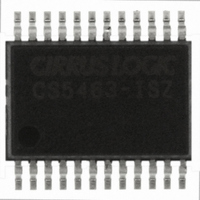CS5463-ISZ Cirrus Logic Inc, CS5463-ISZ Datasheet - Page 17

CS5463-ISZ
Manufacturer Part Number
CS5463-ISZ
Description
IC ENERGY METERING 1PHASE 24SSOP
Manufacturer
Cirrus Logic Inc
Datasheet
1.CS5463-ISZ.pdf
(46 pages)
Specifications of CS5463-ISZ
Package / Case
24-SSOP
Input Impedance
30 KOhm
Measurement Error
0.1%
Voltage - I/o High
0.8V
Voltage - I/o Low
0.2V
Current - Supply
2.9mA
Voltage - Supply
4.75 V ~ 5.25 V
Operating Temperature
-40°C ~ 85°C
Mounting Type
Surface Mount
Meter Type
Single Phase
Output Voltage Range
2.4 V to 2.6 V
Input Voltage Range
2.4 V to 2.6 V
Input Current
25 nA
Power Dissipation
500 mW
Operating Temperature Range
- 40 C to + 85 C
Mounting Style
SMD/SMT
Input Voltage
5.25V
No. Of Outputs
3
Power Dissipation Pd
500mW
Supply Voltage Range
3.3V To 5V
No. Of Pins
24
Filter Terminals
SMD
Supply Voltage Min
3.3V
Rohs Compliant
Yes
Frequency
20GHz
Lead Free Status / RoHS Status
Lead free / RoHS Compliant
For Use With
598-1553 - BOARD EVAL & SOFTWARE CS5463 ADC
Lead Free Status / Rohs Status
Lead free / RoHS Compliant
Other names
598-1096-5
Available stocks
Company
Part Number
Manufacturer
Quantity
Price
Company:
Part Number:
CS5463-ISZ
Manufacturer:
CIRRUS
Quantity:
39
Company:
Part Number:
CS5463-ISZ
Manufacturer:
CS
Quantity:
1 045
Part Number:
CS5463-ISZ
Manufacturer:
CIRRUS
Quantity:
20 000
Company:
Part Number:
CS5463-ISZR
Manufacturer:
CYPRESS
Quantity:
1 001
Part Number:
CS5463-ISZR
Manufacturer:
CIRRUS
Quantity:
20 000
for unsigned registers is a normalized value between 0
and 1. A register value of
represents the maximum possible value.
At each instantaneous measurement, the CRDY bit will
be set in the Status Register , and the INT pin will be-
come active if the CRDY bit is unmasked in the Mask
Register . At the end of each computation cycle, the
DRDY bit will be set in the Status Register , and the INT
pin will become active if the DRDY bit is unmasked in
the Mask Register . When these bits are asserted, they
must be cleared before they can be asserted again.
If the Cycle Count Register (N) is set to 1, all output cal-
culations are instantaneous, and DRDY, like CRDY, will
indicate when instantaneous measurements are fin-
ished. Some calculations are inhibited when the cycle
count is less than 2.
Epsilon (
the sample frequency (f
where f
and clock divider K = 1, f
most-common line frequencies, 50 Hz and 60 Hz
and
respectively. Epsilon is used to set the frequency of the
internal sine/cosine reference for the fundamental ac-
tive and reactive measurements, and the gain of the 90°
phase shift (IIR) filter for the average reactive power.
5.5 Energy Pulse Output
The CS5463 provides three output pins for energy reg-
istration. By default, E1 registers active energy, E3 reg-
isters reactive energy, and E2 indicates the sign of both
active and reactive energy. (See Figure 2.
gram for E1, E2, and E3
put is designed to register the Active Energy. The E2 pin
can be set to register Apparent Energy. Table 2 defines
DS678F2
s
ε
= MCLK / (K*1024). With MCLK = 4.096 MHz
) is the ratio of the input line frequency (f
ε
ε
=
(
----------------------- -
=
2
50 Hz 4000 Hz
23
2
60 Hz 4000 Hz
23
–
1
s
)
ε
) of the ADC.
⁄
on page13.) The E1 pulse out-
⁄
=
=
0.99999988
s
f
i
= 4000 Hz. For the two
⁄
f
s
=
=
0.0125
0.015
Timing Dia-
i
) to
Figure 5. Active and Reactive energy pulse outputs
the pulse output mode, which is controlled by bit
E2MODE in the Operational Mode Register.
The E3 pin can be set to register Reactive Energy (de-
fault), PFMON, Voltage Channel Sign, or Apparent En-
ergy. Table 3 defines the pulse output format, which is
controlled by bits E3MODE[1:0] in the Operational
Mode Register.
The pulse output frequency of E1, E2, and E3 is directly
proportional to the power calculated from the input sig-
nals. The value contained in the PulseRateE Register is
the ratio of the frequency of energy-output pulses to the
number of samples, at full scale, which defines the av-
erage frequency for the output pulses. The pulse width,
t
Width register, and is approximately equal to:
If MCLK =
t
5.5.1 Active Energy
The E1 pin produces active-low pulses with an output
frequency proportional to the active power. The E2 pin
is the energy direction indicator. Positive energy is rep-
resented by E1 pin falling while the E2 is high. Negative
energy is represented by the E1 pin falling while the E2
is low. The E1 and E2 switching characteristics are
specified in Figure 2.
on page13.
Figure 5 illustrates the pulse output format with positive
active energy and negative reactive energy.
pw
pw
E 1
E 2
E 3
E3MODE1 E3MODE0
≅
in Figure 2, is programmable through the Pulse-
0.25
0
0
1
1
E2MODE
t pw sec
ms.
4.096
Table 2. E2 Pin Configuration
Table 3. E3 Pin Configuration
(
0
1
)
MHz, K =
≅
PulseWidth
0
1
0
1
Timing Diagram for E1, E2, and E3
E2 Output Mode
Apparent Energy
Sign of Energy
1, and PulseWidth = 1,
•
Voltage Channel Sign
----------------------------------------------- -
( MCLK/K ) / 1024
E3 OutPut Mode
Apparent Energy
Reactive Energy
PFMON
1
CS5463
then
17



















